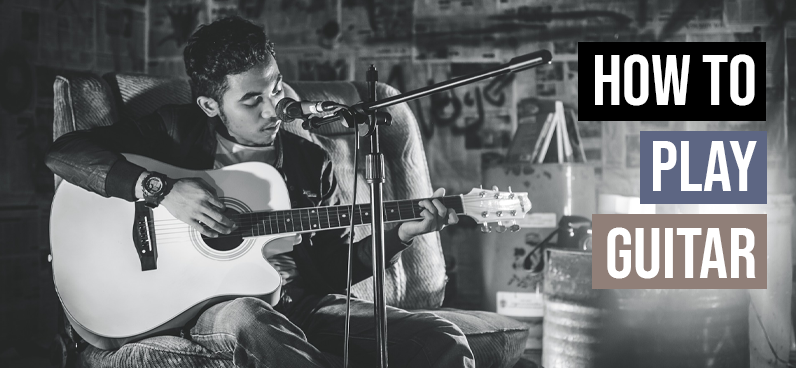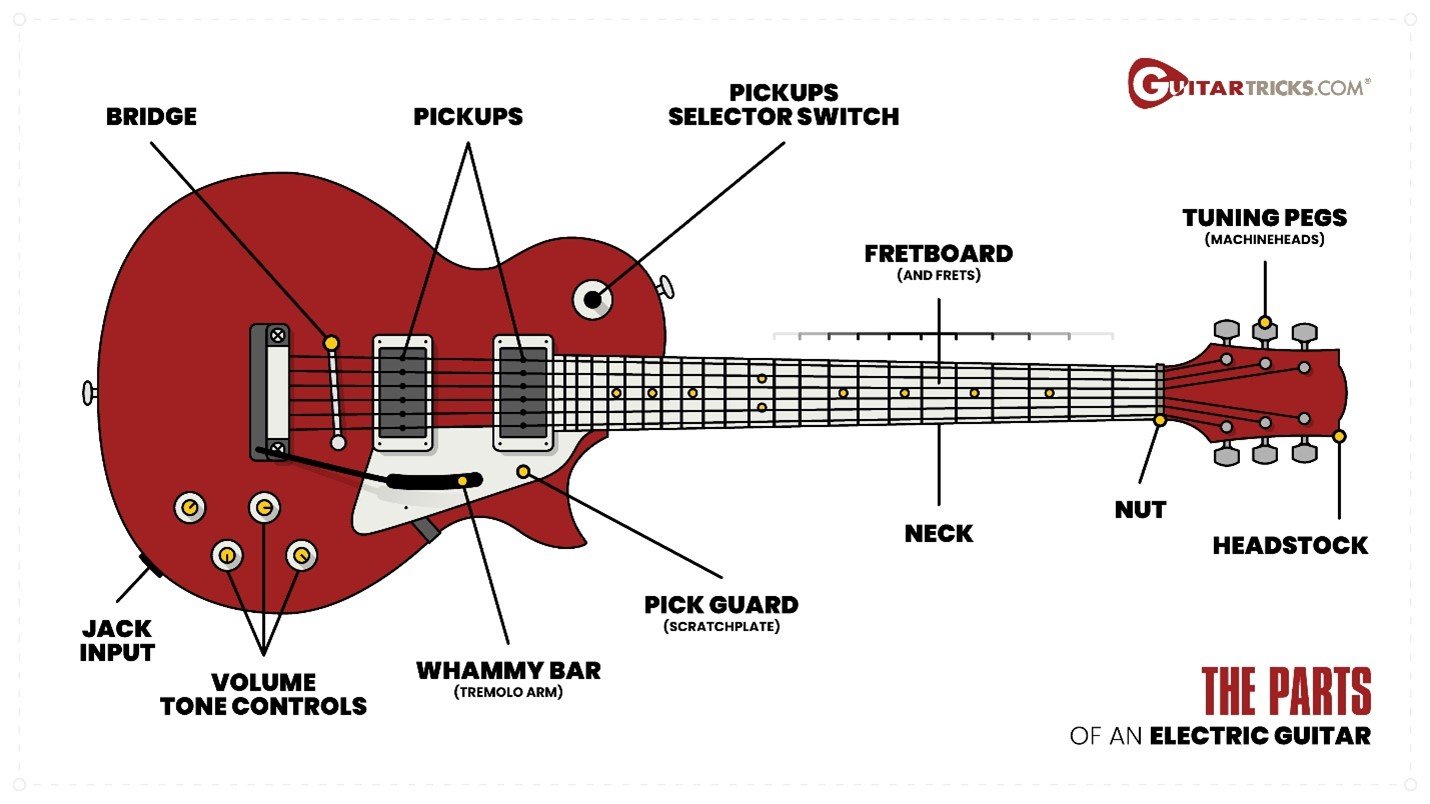
If you have never played guitar before, in this article we will walk you through the first steps for those taking beginner guitar lessons. And while learning an instrument does not occur overnight, if you follow these pointers on a consistent basis, you will see regular progress. Remember that playing the guitar is a physical exercise, it is essential to train and retain your muscle memory to accomplish it.
Know Your Guitar
A guitar is a chordophone, which includes other instruments like the ukulele, mandolin, banjo, and most plucked strings. This ability to play chords and melodies is what has helped make the guitar so popular, and unlike a piano or keyboard it is lighter and more portable. It can help to have a keyboard or even a piano app on your phone when tuning, reviewing your music theory, or visualizing your notes across the fretboard.

At the top of a guitar, we have the headstock and tuners which allow us to adjust the pitch, the strings connect to the tuners and run across the nut onto the fretboard. Each metal fret is one semitone note higher, the same as moving one piano key at a time. The fat low strings are the bass, and the higher thin strings are the treble. Be sure your guitar is intonated right, which means each string should play the right pitch.
As we move up the fretboard we must be sure our strings are not hard to press or have any dead sounds. The strings are attached to the body at the bridge and saddle depending on the style. If you play electric guitar, the intonation is easier to adjust unlike an acoustic guitar with a fixed bridge. If possible have a professional give the guitar a setup and check to be sure it is playable, some cheap models will not play chords if the intonation is off.
Holding and Strumming Your Guitar
Poor posture and incorrect handling of a guitar are common bad habits that occur from your very first try. Always be sure to sit up and know that the guitar is manageable for your size. Electrics are great to start on as they are more compact and easier to reach the strings. If the guitar is too big you are going to have a harder time initially learning.
Strumming Patterns: Using The Strumming Pattern
The body will rest on your lap while your dominant hand does the strumming, and your other hand plays the fretted notes. Your picking arm needs to firmly grip the body, but not too tight. And the fretting hand needs to be angled out so you can press the strings down without muting the ones nearby. You mostly hold the guitar with your picking arm, the headstock is lightly supported as we fret notes.
A down stroke starts on the low bass string and continues all the way across the strings. In reverse an up stroke moves from the treble back to the bass. Beginner guitar tablature and music will often have symbols for when to strum a downstroke and upstroke to help with playing patterns. Heavy metal and hard rock often have repetitive downstrokes while most pop and R&B styles have regular alternate picking.
Tuning and Playing
Most guitarists play in the tuning of EADGBE, which goes from the bass to the treble. Learning to tune by ear is one of the best first steps as it helps you visualize the fretboard better. But using a tuner is ok, be sure to have a good guitar tuner that shows you the difference between the E2 and E4 octave if possible, that way you know you are on the mark.
Tuning And Playing Notes: Learning The String Names
After tuning you can start playing. When you fret, always press down slightly before the metal. You may have to find the sweet spot on your guitar to be sure that the note or chord you play is clear, and you will have to be careful not to have your fingers touch other strings. This will cause the muted and screeching sounds that you hear when you first strum. Find the fleshy part of the fingertips that allows you to firmly press and get a clean sound.
As you notice it will get a little harder to fret as the strings move up the fretboard, hopefully not too hard or you have a problem with your action. Later when we start playing barre chords it will hurt the hands, so proper action and setup really is important. Whether you use a pick or fingerstyle, each note must sound correct and clear when you play it, if not the guitar will not sound right.
Learn Songs and Chords
Before the days of online blogs people learned guitar by watching, listening, and copying what they saw. You can do the same but with the help of vast resources! Be sure that your lessons are song and chord oriented at first. Guitar scales and keys are essential to learn, but first we just want to play something right and feel good about it.
Simple Chords: The One-Finger G Major Chord
The three easiest chords for most beginners are G, C, and D. Once you know these three chords, you’ll already be able to play hundreds of easy guitar songs! But you may find other particular chords are easier to play. You discover which guitar chords are the easiest by looking up all your favorite songs. Look up the chords with a guitar chord chart and follow the fingerings, if a song is too hard, try another. This process helps you get an idea of different fretboard positions to play chords and melodies on and gives you a great idea of chord progressions.
Modern music is mostly centered around very specific and repetitive chord sequences and progressions. This is why it is possible to easily jam with musicians, they follow progressions like the I-IV-V, which for the key of G is G-C-D. These three chords can play a lot of songs, add the vi in and we can get even more songs with G-Em-C-D. Find which keys and chord groupings are the best for your fingers and voice by playing as many songs as possible. If you ever get stumped, or want to know a chord you just heard of, look it up with a guitar chord finder.
Hone Your Picking and Rhythm
So far our chord focus has been mostly on the fretting hand, which is essential to play correctly, or the sound will be off. But also be sure to look up various picking styles after your initial up and down strumming. Sometimes picking patterns accent the bass notes, while other times they may sweep across like a roll or heavy metal riff. As you play new songs pay attention to the picking style and rhythm.
Basic Rhythmic Subdivisions: Whole And Half Notes
Rhythm is not an easy thing to learn and is best done by playing along with the song as you go. Some jazz musicians turn a metronome down to 50 BPM and then pretend the click is the 2 and 4 beats on the 1 2 3 4, which can help a student with swing and syncopation. Otherwise playing rhythm is hard to describe and teach, you simply must keep at it and find the groove.
Another great guitar practice that will hone your rhythm and chord playing is using a drum machine, app, or backing track. They provide different musical genres and vibes that you can riff with chords and scales over. Pick a progression like G-C-D, start a drum pattern, and just start noodling over it. Make practice as enjoyable as possible that way you get positive results and want to do it again!
Learn Your Music Theory and Train the Ear
While things like the Circle of Fifths and Nashville Numbering System may seem initially strange, it is helpful to pay attention to theory from early on. Music theory is not set in stone and perfect; it is ambiguous and even the experts argue. But it is a basis and guide that will help you be a better guitarist and musician.
And most of all, the lost art of ear training is very essential. Don’t just play guitar tabs and practice picking techniques, really listen to the beginner guitar songs you learn. Listen to each member of the band and try to pick out specific notes and chords on your guitar. Pretend it is 100 years ago and this instrument and the radio is all you have, that is how the great guitarists often did it!
Learning guitar is going to be difficult, as you will often screech, or squawk and it may seem like progress is impossible. But this is just the first of many hills that you must cross to accomplish the goal. Study your instrument, songs, and a variety of online guitar lessons and soon the big picture will come into focus. But most of all you need to physically train the muscle memory in your hands with repetition and lots of practice.